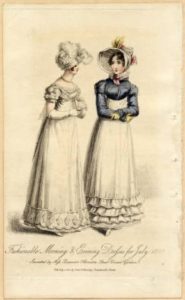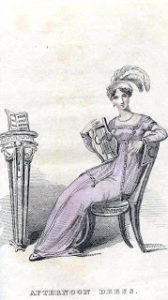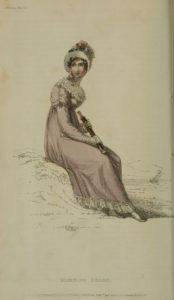
From what I have been able to determine, morning was the time of day before dinner. Therefore, Morning Dress is what one wore during the day until dinner—not just in the hours before noon. A wedding breakfast or a Venetian breakfast could be held as late as 1:00 o’clock in the afternoon. Basically, breakfast was the main meal served before dinner. With that in mind, morning gowns were what ladies wore for functions such as at-homes, paying calls, shopping, etc. Depending on their wealth and personality, ladies probably wore an old morning gown for around the house if they did not expect callers.
Most engravings I have found labeled “Morning Dress” show a gown, often white, with some kind of robe-like garment with long sleeves over it labeled as a “loose robe pelisse” often with lots of ruffles. A dressed-up morning dress would be appropriate for afternoon calls, with a spencer or pelisse. People paid “morning calls” between 2:00 pm and 4:00 pm and wore Morning Dress. I know, confusing, right? It gets worse.
Some Regency fashion plates use the term “afternoon dress” when showing a picture of what is clearly an evening gown. Afternoon, as a label for a time of day, came either after the Regency, or perhaps very late Regency. but was not be widely used until later in the century.
The problem is, other fashion magazines used the term evening gown for the same time of day as those called afternoon. Obviously, one wouldn’t attend a dinner party wearing an afternoon gown, then around midnight, change into an evening gown. They changed clothing frequently, but they weren’t that crazy!
So, based on what I have researched, the day was divided into morning which lasted until dinner, evening which lasted until supper, and night which lasted until morning. To make it easier on my readers, I have decided to stick to present-day usage for those terms. As you may have guess, the language isn’t truly secret, but it is certainly perplexing to our modern understanding.

The Secret Language of Regency Fashion posted first on http://donnahatchnovels.tumblr.com/

No comments:
Post a Comment